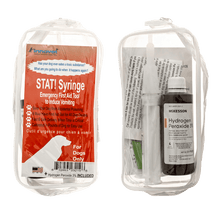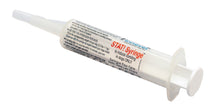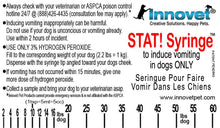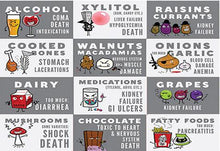
For Dogs Only (not for CATS or HUMANS!!)
Each year countless dogs are killed by accidental ingestion of chocolate, rat poison, antifreeze and prescription pills. If your pet got into something poisonous, you always want to call your veterinarian or an animal poison control center first. Why? Because sometimes you can cause more injury or harm if you induce vomiting when it’s not appropriate. If instructed to induce vomiting, the STAT!Syringe is designed to quickly administer the proper dose of hydrogen peroxide 3%. It is a must have for every dog first aid kit.
How to induce vomiting in dogs: Downloadable STAT!Syringe PDF
You will need:
- -Standard household Hydrogen Peroxide 3% (do not use any other type!)
- -STAT!Syringe
- -Paper towels
Fill the STAT!Syringe up to the notch corresponding to your dog's weight with the 3% Hydrogen Peroxide. Place the soft tip of the syringe into the side of your dog's mouth and angle it toward the cheek. Slowly press the plunger of the syringe until the entire dose is delivered. You may repeat this dose for a maximum of two times but wait at least 15 mins between doses. Walking your dog around may help to expedite the process. If still does not vomit after another 10 minutes, bring your dog and the chemical bottle or other toxin to the vet at once as the vet may have stronger products to induce vomiting.
It worked! Now what?
Vomiting is a quick fix, intended to get the offending substance out of the animal's system and to give you time to get to your veterinarian; a trip to the vet is still warranted for precautionary measures. Depending on what was ingested, activated charcoal may need to be given by a healthcare provider to help bind any residual poison and to prevent further absorption. Because there may be important clues needing to be discovered, be sure to save the vomitus to show your veterinarian.
When to induce vomiting?
- -If you come home to discover your dog has eaten chocolate, sugarless gum, fertilizer, alcohol, grapes, mushrooms, prescription or recreational drugs, walnuts, macadamia nuts, raisins, yeast dough, onions and certain foreign objects.
- -If the substance ingested was poisonous
- -Recent ingestion (2 hours maximum)
- -Your dog is asymptomatic, meaning he’s not showing any signs of the poisoning at all
- -Your dog is healthy and isn’t at risk for inhaling the vomit into his lungs (e.g., he doesn’t have previous medical problems like an abnormal airway, laryngeal paralysis, collapsing trachea, an abnormal esophagus, NOTE: Brachycephalic dogs with a smooshed face are at more risk for inhaling his vomit into the lungs. Brachycephalic breeds include the following: English bulldogs, Pekingese, Shih-Tzus, Pugs.
- -Contact Animal Poison Control at (888) 426-4435 and let them tell you how best to handle the situation. You can also try Angel Animal poison control hotline at 877-226-4355 or PROSAR international animal poison control at 888-232-8870. Please keep in mind that there is usually a credit card charge around 50 to 60 dollars for the consultation.
When NOT to induce vomiting?
- -DO NOT induce vomiting if the toxin is caustic like drain opener, acidic like battery acid, or a petroleum-based product. If you are unsure about the kind of toxic material that was ingested, contact Animal Poison Control at (888) 426-4435 and let them tell you how best to handle the situation. Please note that a fee may be assessed for this phone call.
- -DO NOT induce vomiting if the animal is having difficulty breathing, having seizures/convulsions, seems depressed, in shock or unconscious.
- -DO NOT induce vomiting if the animal's heart rate is very slow, if the object eaten was pointed or sharp, or when the poison container says not to.
- -We never recommend inducing vomiting with these types of poisons: Corrosive chemicals (e.g., oven cleaners, bleach, drain cleaners, batteries, lime removal products, etc.) – can cause more damage to the esophagus if you induce vomiting. Hydrocarbons or petroleum distillates (e.g., kerosene, gasoline, motor oil, etc.). These oily substances are easily inhaled into the lungs, causing a severe aspiration pneumonia. These chemicals can cause burning as they are swallowed, and secondary additional burns as they come back up. Don't induce vomiting if your pet has swallowed a caustic substance.
- -DO NOT induce vomiting if he's already throwing up. Don't induce more vomiting in an already vomiting animal, because you can incite a worse vomiting response.
- -DO NOT induce vomiting if your pet has lost consciousness and/or if she's very weak or has trouble standing. Do not induce vomiting in this situation because aspiration pneumonia, which can result when an animal inhales vomit into its lungs, can become a secondary problem.
- -DO NOT induce vomiting if it has been over two hours since your pet ingested a potential toxin. Once a substance enters your pet's small intestine, vomiting will not clear the stomach of that toxin. Inducing vomiting in a dog or cat that has already digested a potential toxin won't be effective in ridding her body of the substance.
- -DO NOT induce vomiting in dogs using any of these methods: -Physically sticking a finger down the throat (yes, people do this and it’s completely asinine!) -Mustard -Salt (due to side effects from causing a very elevated sodium level) -Syrup of ipecac (due to profound side effects)
Again, always check with your veterinarian or an animal poison control center first prior to inducing vomiting. Sometimes it can be too late or can cause more harm if you induce vomiting inappropriately.
Cat owners should be aware of the following: There’s nothing you can safely give to CATS if they’ve eaten something poisonous. Products like salt, mustard, ipecac syrup, and hydrogen peroxide aren’t safe to give in cats, and you need to seek immediate veterinary attention if your cat ate something poisonous. Your veterinarian has more effective drugs called alpha-adrenergic agonist drugs to help induce vomiting.
Two more key points to remember: 1) Hydrogen Peroxide will flatten as it ages thus losing its effectiveness for inducing vomiting. Always have an unopened bottle handy that is within the expiration date. 2) For some dogs peroxide works within seconds of administering so be sure to give outside or in an area that is easy to clean.
DISCLAIMER: This article must not be used as a substitute for veterinary care nor should it be used as a diagnostic tool. Always consult a vet should you believe your dog has been in contact with toxins or poisons, a delay in doing so can turn potentially dangerous or even fatal. Always keep handy the Poison control phone numbers to refer to during such emergencies.
Common Poisonous Plants
The American Society for the Prevention of Cruelty to Animals (ASPCA) released a list of the 10 most common poisonous plants (inside and out) and their possible effects. Research these plans online to familiarize yourself with what they look like. You may already have them in your home and not know it.
|
Plant |
Possible Effects |
|
Marijuana |
Depression of the central nervous system and incoordination, diarrhea, vomiting, drooling, increased heart rate, seizures and coma |
|
Sago Palm (Popular landscape item) |
Vomiting, diarrhea, depression, seizures, and liver failure (The seeds contain the largest amount of toxin, though all parts are poisonous.) |
|
Lilies |
Severe kidney damage. *Felines in particular are at risk; they like to chew on flower bouquets that usually include lilies |
|
Tulips/Narcissus bulbs |
Intense gastrointestinal irritation, drooling, loss of appetite, depression of the central nervous system, convulsions, and cardiac abnormalities |
|
Azalea/Rhododendron |
Vomiting, drooling, diarrhea, weakness and depression of the central nervous system. Severe poisoning can lead to coma and death from cardiovascular collapse |
|
Gastrointestinal tract irritation, abnormal heart function, hypothermia (low body temperature), and death |
|
Castor Bean |
Severe abdominal pain, drooling, vomiting, diarrhea, excessive thirst, weakness and loss of appetite – severe cases can result in dehydration, muscle twitching, tremors, seizures, coma, and death |
|
Cyclamen(Houseplant given at holidays) |
Gastrointestinal irritation, intense vomiting, and even death |
|
Kalanchoe(Flowering houseplant) |
Gastrointestinal irritation and arrhythmia
|
|
Yew |
Trembling, incoordination, difficulty breathing, gastrointestinal irritation, and cardiac failure |


















